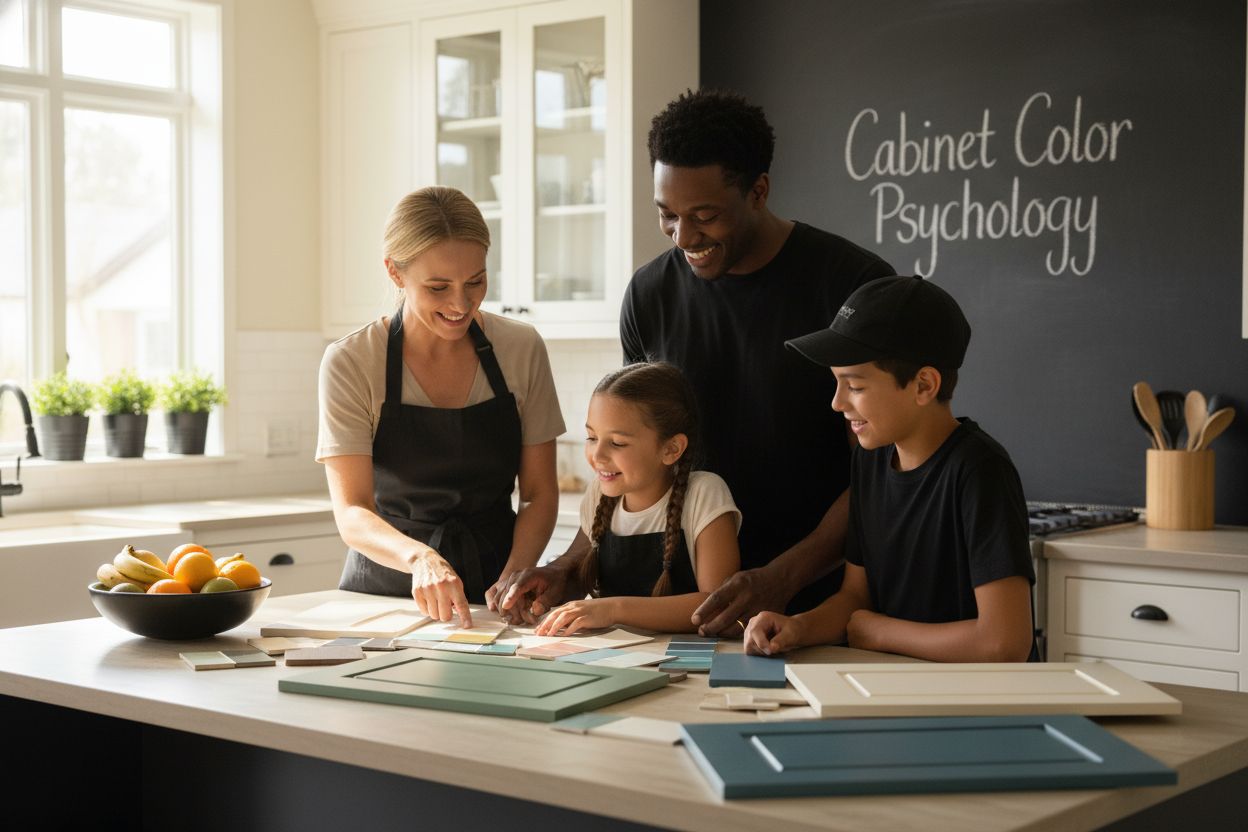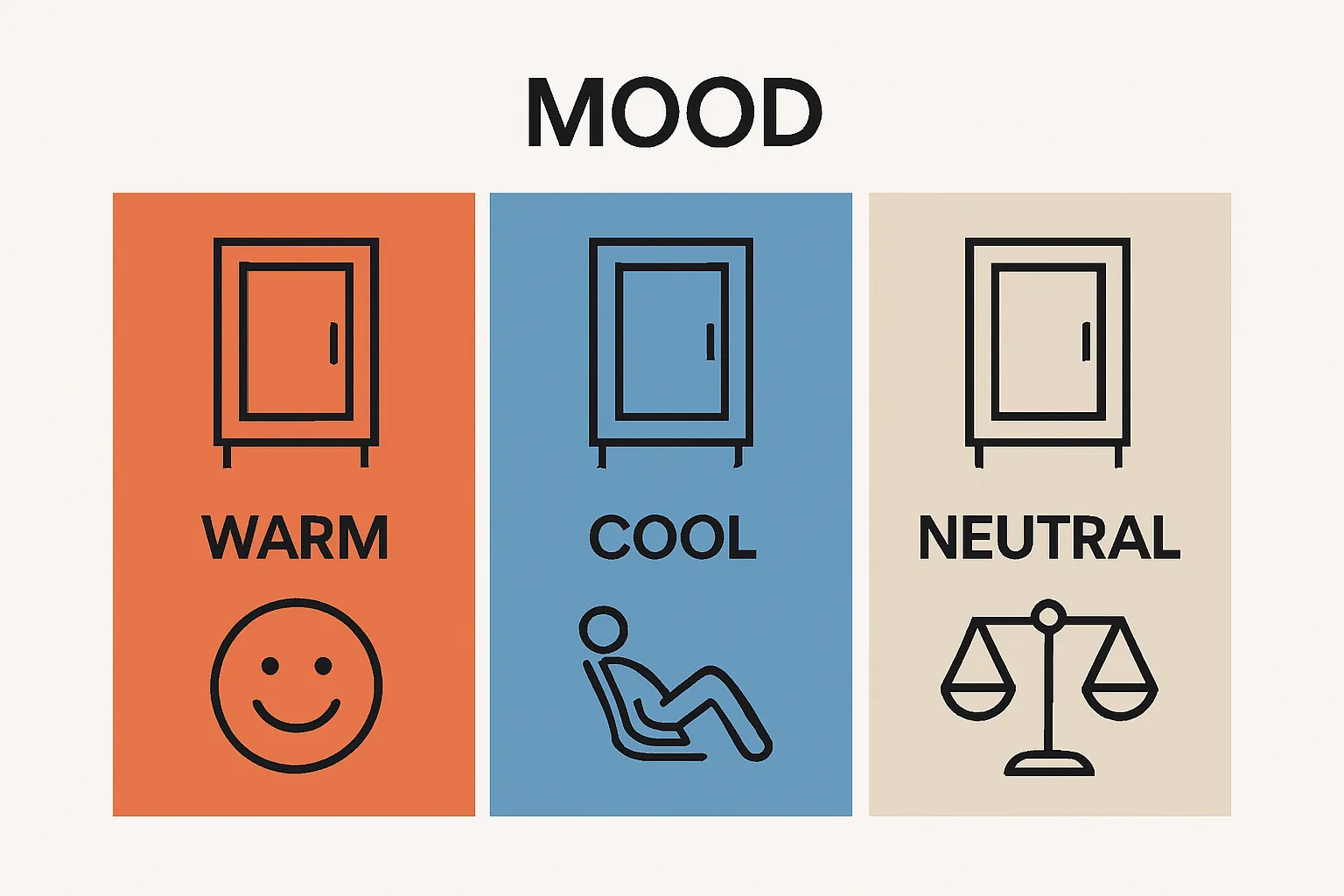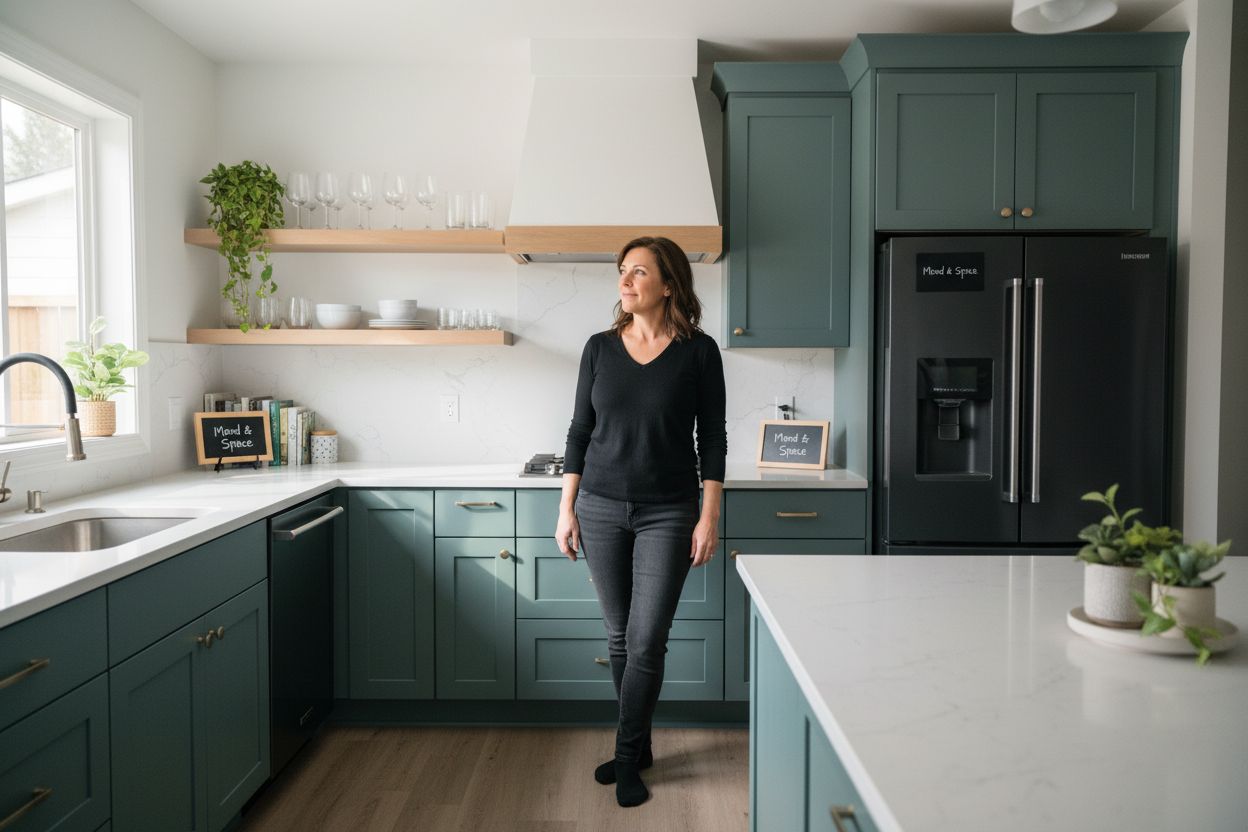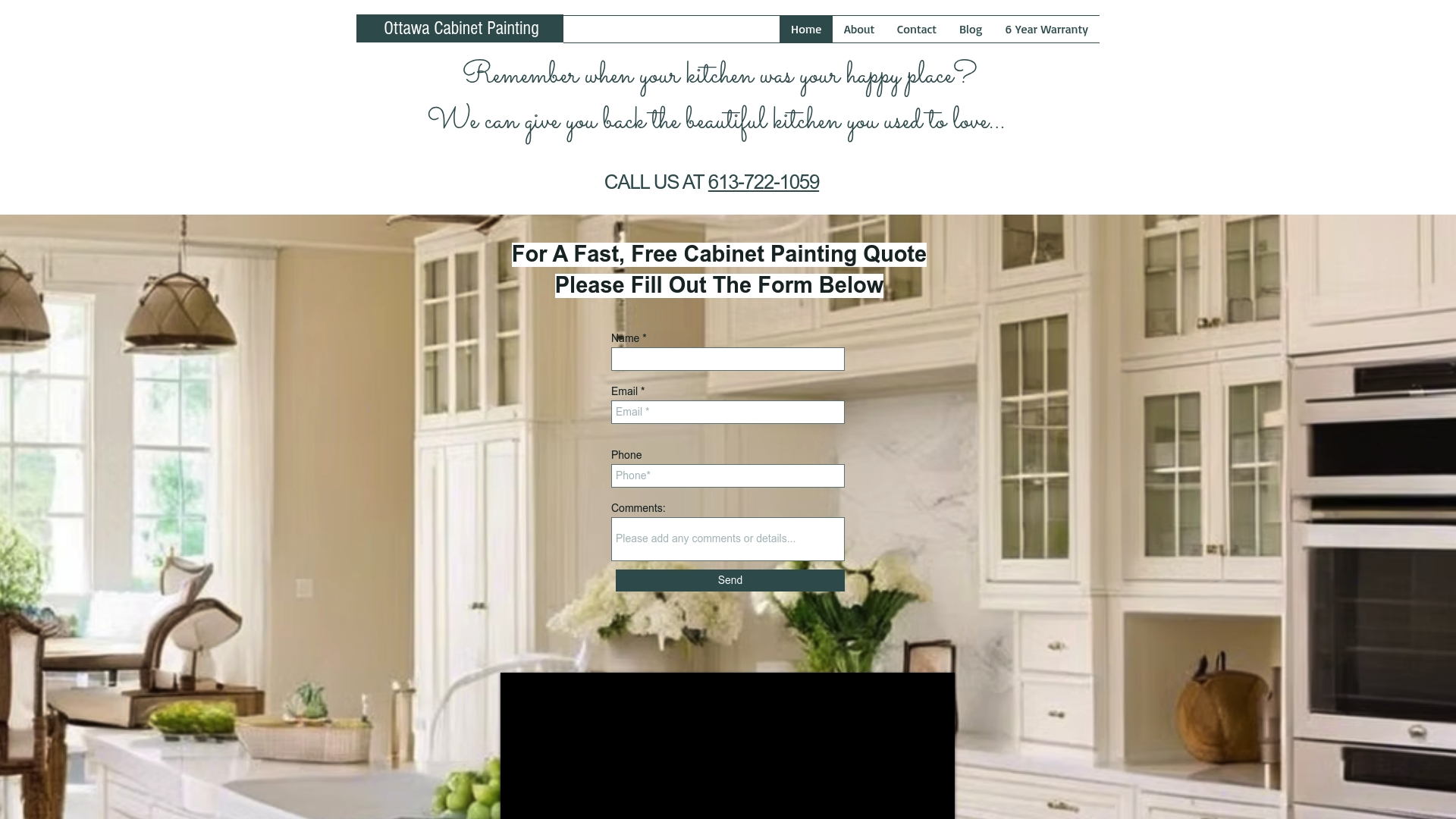Understanding Cabinet Color Psychology for Your Home
- demoore5506
- Oct 6
- 8 min read

Every choice you make in your kitchen matters and cabinet color is no exception. Most people think picking a paint shade is just about matching the counters or following trends. But research shows that cabinet colors can actually shift your mood, increase appetite, or make your kitchen feel up to twice as large depending on the hue you choose. So that calm blue you considered last spring might be working harder than you ever expected.
Table of Contents
Quick Summary
Takeaway | Explanation |
Color affects emotional atmosphere | Cabinet colors influence mood, energy levels, and perceived space, impacting daily experiences in kitchens. |
Warm colors stimulate conversations and appetite | Colors like red, orange, and yellow create energy and warmth, encouraging social interaction and enhancing meal enjoyment. |
Cool colors promote calmness and cleanliness | Blues and greens provide a serene environment, reducing stress and enhancing the perception of spaciousness in kitchens. |
Consider long-term color sustainability | Choose cabinet colors that align with personal style and existing decor for lasting aesthetic appeal and functionality. |
Smart color choices increase home value | Strategic cabinet color selections enhance visual appeal and can positively impact property valuation during resale. |
The Basics of Cabinet Color Psychology
Color psychology represents a fascinating intersection between design and human emotional response, particularly when applied to interior spaces like kitchens. When selecting cabinet colors, homeowners are not merely choosing a visual aesthetic but creating an emotional environment that profoundly influences daily experiences. Explore our comprehensive guide on understanding cabinet color choices.
The Emotional Impact of Color
Colors communicate silently, triggering specific psychological and physiological reactions. In kitchen design, cabinet colors serve as substantial visual surfaces that dramatically shape room perception and emotional atmosphere. According to research from the American Psychological Association, different color hues can significantly impact mood, energy levels, and perceived space.
Key psychological responses to cabinet colors include:

Warm Colors (Reds, Oranges, Yellows): Stimulate conversation, increase appetite, create energy and warmth
Cool Colors (Blues, Greens): Promote calmness, reduce stress, create a sense of cleanliness and spaciousness
Neutral Colors (Whites, Grays, Beiges): Provide versatility, create a sense of balance and sophistication
Practical Color Selection Principles
Successful cabinet color psychology goes beyond aesthetic preferences. Consider these critical factors when selecting colors:
Room size and natural light availability
Existing kitchen color palette
Personal emotional response to specific colors
Long-term design sustainability
Understanding these principles helps create kitchen spaces that are not just visually appealing but emotionally resonant.
The following table compares the psychological effects and design qualities of warm, cool, and neutral cabinet colors to help homeowners make informed color choices.
Color Type | Psychological Effect | Design Qualities |
Warm (Red, Orange, Yellow) | Stimulates conversation, increases appetite, creates energy and warmth | Inviting, energetic, enhances social atmosphere |
Cool (Blue, Green) | Promotes calmness, reduces stress, creates a sense of cleanliness and spaciousness | Serene, tranquil, visually expands space |
Neutral (White, Gray, Beige) | Provides versatility, creates balance and sophistication | Elegant, timeless, matches various styles |
Why Cabinet Colors Matter in Your Home
Cabinet colors represent more than aesthetic choices they are powerful design elements that transform living spaces and influence psychological experiences. Beyond surface decoration, cabinet colors act as silent communicators of mood, style, and personal expression. Read our latest guide on modern kitchen color trends.
Psychological and Emotional Influence
According to research from the National Institutes of Health, interior colors profoundly impact human psychology and emotional well-being. Cabinet colors specifically shape how individuals perceive and interact with their living spaces. They can:
Create emotional atmosphere
Influence perceived room temperature
Enhance or diminish spatial perception
Communicate personal style and personality
Functional Impact of Color Selection
Smart cabinet color selection transcends visual appeal and directly influences practical aspects of home living. Different colors interact uniquely with light, space, and existing design elements. Homeowners who strategically choose cabinet colors can achieve multiple functional benefits:
Maximize perceived room size
Improve natural light reflection
Complement existing architectural features
Create visual harmony across different home areas
The nuanced relationship between cabinet colors and living environment demonstrates that color is not merely decorative but a strategic design tool. Thoughtful color selection transforms kitchens from simple functional spaces into personalized sanctuaries that support emotional well-being and aesthetic satisfaction.
How Color Influences Mood and Space
Color represents a profound psychological language that communicates emotions, shapes perceptions, and transforms spatial experiences within our homes. Selecting the right cabinet colors can dramatically alter how we perceive and interact with interior environments. Discover timeless kitchen color schemes for your home.
The Neurological Impact of Color Perception
Researchers from Harvard Medical School have demonstrated that color interactions trigger specific neurological responses, influencing brain chemistry and emotional states. Different wavelengths of color stimulate distinct neural pathways, creating immediate psychological and physiological reactions.
Key neurological responses to color include:
Rapid emotional processing
Unconscious mood modulation
Physiological stress reduction
Enhanced cognitive performance
Spatial Perception and Color Dynamics
Colors possess remarkable abilities to manipulate spatial perception beyond mere visual aesthetics. Lighter colors expand perceived space, while darker tones create intimate, compressed environments. Strategic color selection allows homeowners to optically transform room dimensions without structural modifications:
Light colors reflect more light, creating openness
Dark colors absorb light, generating depth
Cool tones recede visually
Warm tones advance spatially
Understanding color’s intricate relationship with human perception empowers homeowners to design spaces that not only look beautiful but actively support emotional well-being and psychological comfort.

Cabinet colors emerge as powerful tools for crafting environments that resonate with individual sensibilities and enhance daily living experiences.
The Impact of Color Choices on Kitchen Upgrades
Kitchen upgrades represent significant investments where color choices become critical strategic decisions that influence aesthetic appeal, emotional experience, and property value. Color selection transcends mere decoration, functioning as a powerful design language that communicates style, personality, and potential. Explore popular kitchen color schemes for Ottawa homes.
Economic and Aesthetic Value
According to research from Houzz, strategic cabinet color choices can significantly impact home valuation and market perception. Smart color selections offer multiple economic advantages:
Increased property resale potential
Enhanced visual appeal for potential buyers
Reduced renovation costs compared to full remodels
Improved overall home marketability
Psychological Considerations in Color Selection
Color choices act as silent communicators of home atmosphere and personal style. Different color palettes trigger specific psychological responses, transforming kitchen spaces from mere cooking areas into dynamic living environments. Critical considerations include:
Alignment with existing home design
Personal emotional resonance
Long-term aesthetic sustainability
Compatibility with natural and artificial lighting
The nuanced relationship between color selection and kitchen upgrades demonstrates that thoughtful design goes far beyond surface-level aesthetics. By understanding color’s profound psychological and economic implications, homeowners can create spaces that are not just visually stunning but emotionally resonant and financially strategic.
Real-World Examples of Cabinet Color Psychology
Practical applications of cabinet color psychology reveal profound insights into how color transforms living spaces and influences human experiences. Color choices become narrative elements that tell stories about personal style, emotional landscape, and design philosophy. Explore modern farmhouse cabinet color transformations.
Residential Color Transformation Scenarios
Research from the Journal of Interior Design demonstrates how strategic color selections produce remarkable psychological and aesthetic outcomes. Real-world scenarios illustrate color’s transformative power:
Small kitchens using light sage green cabinets appearing more spacious
Warm terracotta tones creating cozy gathering spaces
Navy blue cabinets establishing sophisticated, modern aesthetics
Soft gray cabinets generating calm, minimalist environments
Emotional and Functional Color Mapping
Cabinet colors function as emotional architects, designing invisible psychological landscapes within homes. Different color selections produce specific experiential outcomes:
Bright white cabinets: Generating feelings of cleanliness and purity
Deep forest green: Creating sensations of natural tranquility
Rich burgundy: Establishing dramatic, luxurious atmospheres
Warm beige: Producing feelings of comfort and timeless elegance
These examples demonstrate that cabinet colors are far more than decorative choices. They are powerful design tools that shape human perception, emotional experiences, and spatial interactions, transforming kitchens from mere functional spaces into personalized sanctuaries that reflect individual narratives and sensibilities.
This table provides an at-a-glance summary of how specific cabinet colors can create different emotions and functional outcomes in real residential spaces.
Cabinet Color | Emotional Impact | Functional Outcome |
Light Sage Green | Freshness, tranquility | Makes small kitchens feel more spacious |
Warm Terracotta | Comfort, coziness | Encourages gathering and warmth |
Navy Blue | Sophistication, modernity | Establishes a bold, elegant atmosphere |
Soft Gray | Calm, minimalism | Generates serene, uncluttered environments |
Bright White | Cleanliness, purity | Enhances the sense of light and openness |
Deep Forest Green | Natural tranquility | Connects space to nature, creates restful vibe |
Rich Burgundy | Drama, luxury | Produces a dramatic, luxurious kitchen feel |
Warm Beige | Comfort, timeless elegance | Offers a classic look and sense of comfort |
Transform Your Kitchen With the Power of Color
You have learned how cabinet color psychology can reshape your space, your mood, and even your sense of home. Many homeowners feel overwhelmed by the challenge of choosing the right cabinet color and worry about the mess and high costs of a full renovation. With Ottawa Cabinet Painting, you do not need to settle for a space that feels outdated or chaotic. Our detail-driven cabinet refinishing delivers the high-end look and emotional impact discussed in Understanding Cabinet Color Psychology for Your Home without the expense or stress of replacement.

Ready to upgrade your kitchen with long-lasting color that truly fits your lifestyle? Experience the meticulous prep, premium finishes, and local expertise that Ottawa Cabinet Painting provides. Get your free quote today and begin turning your kitchen into the inviting, uplifting heart of your home. Start now so you can enjoy a truly transformed space sooner.
Frequently Asked Questions
What is color psychology in cabinet design?
Color psychology in cabinet design refers to the study of how different colors influence emotions, perceptions, and behaviors in living spaces, particularly in kitchens. By selecting appropriate cabinet colors, homeowners can create desired emotional atmospheres and enhance their overall living experience.
How do warm colors affect kitchen environments?
Warm colors like reds, oranges, and yellows stimulate conversation and increase appetite. They create a sense of energy and warmth in kitchens, making them feel inviting and dynamic for family gatherings and social events.
What are the benefits of using cool colors for kitchen cabinets?
Cool colors such as blues and greens promote calmness and reduce stress. They create a sense of cleanliness and spaciousness, making a kitchen feel more serene and relaxing, which can be beneficial for daily cooking and family interactions.
How can I choose the right cabinet color for my kitchen?
To choose the right cabinet color, consider factors such as the size of your kitchen, the amount of natural light available, your existing color palette, and your personal emotional response to specific colors. Understanding these elements helps create a cohesive and emotionally resonant kitchen design.
Recommended

Comments